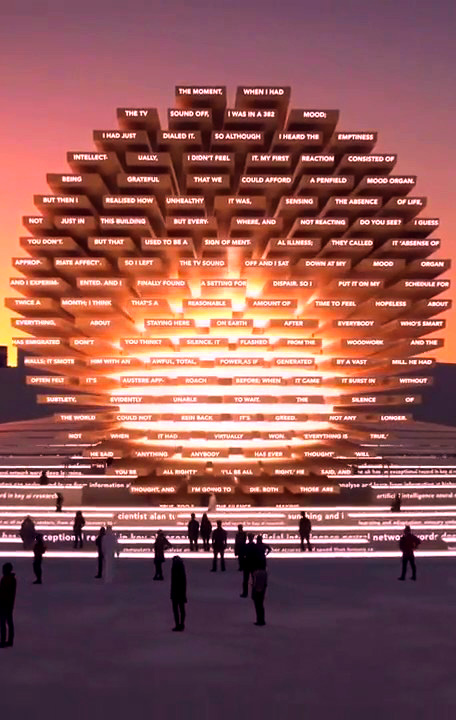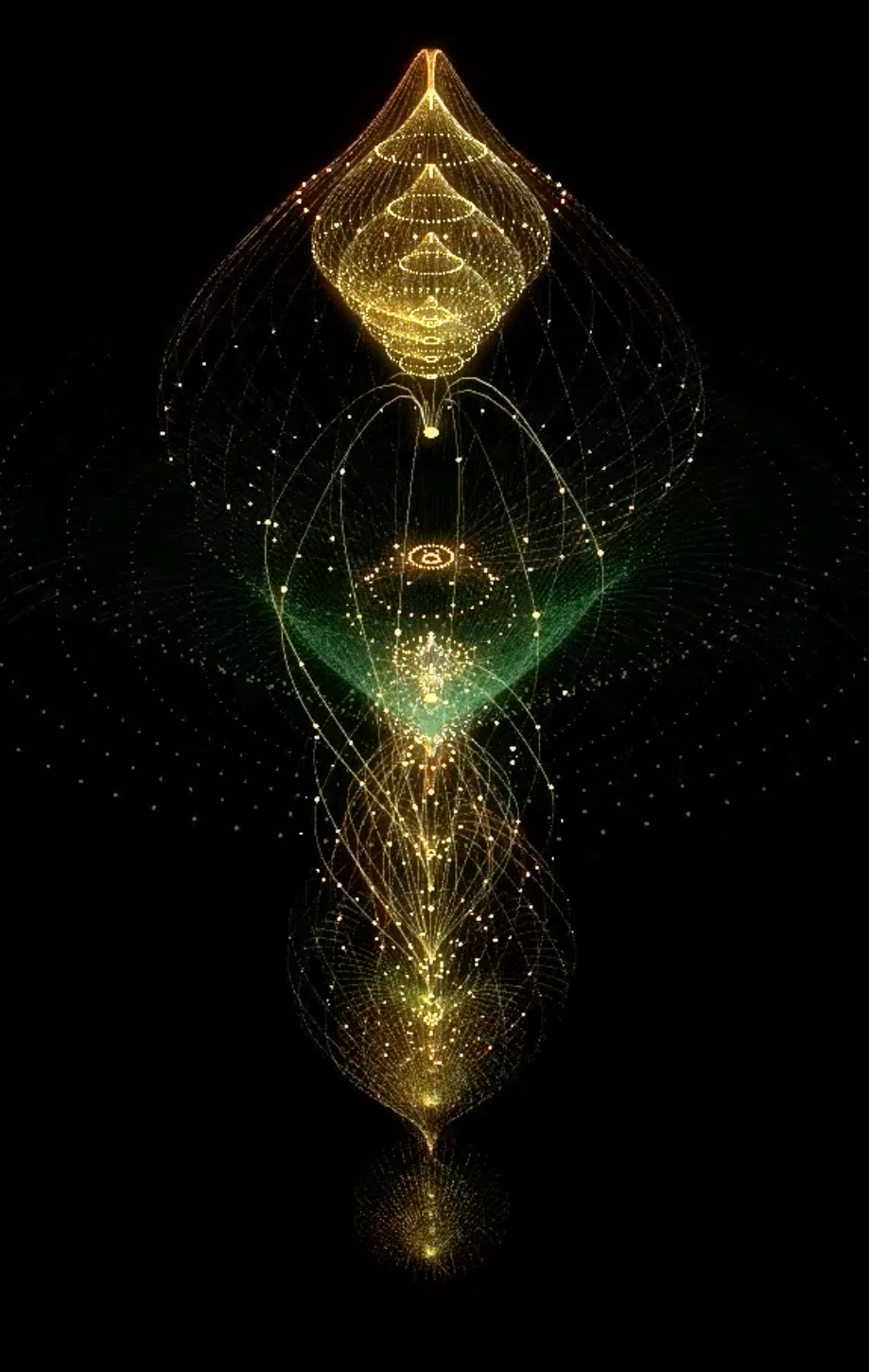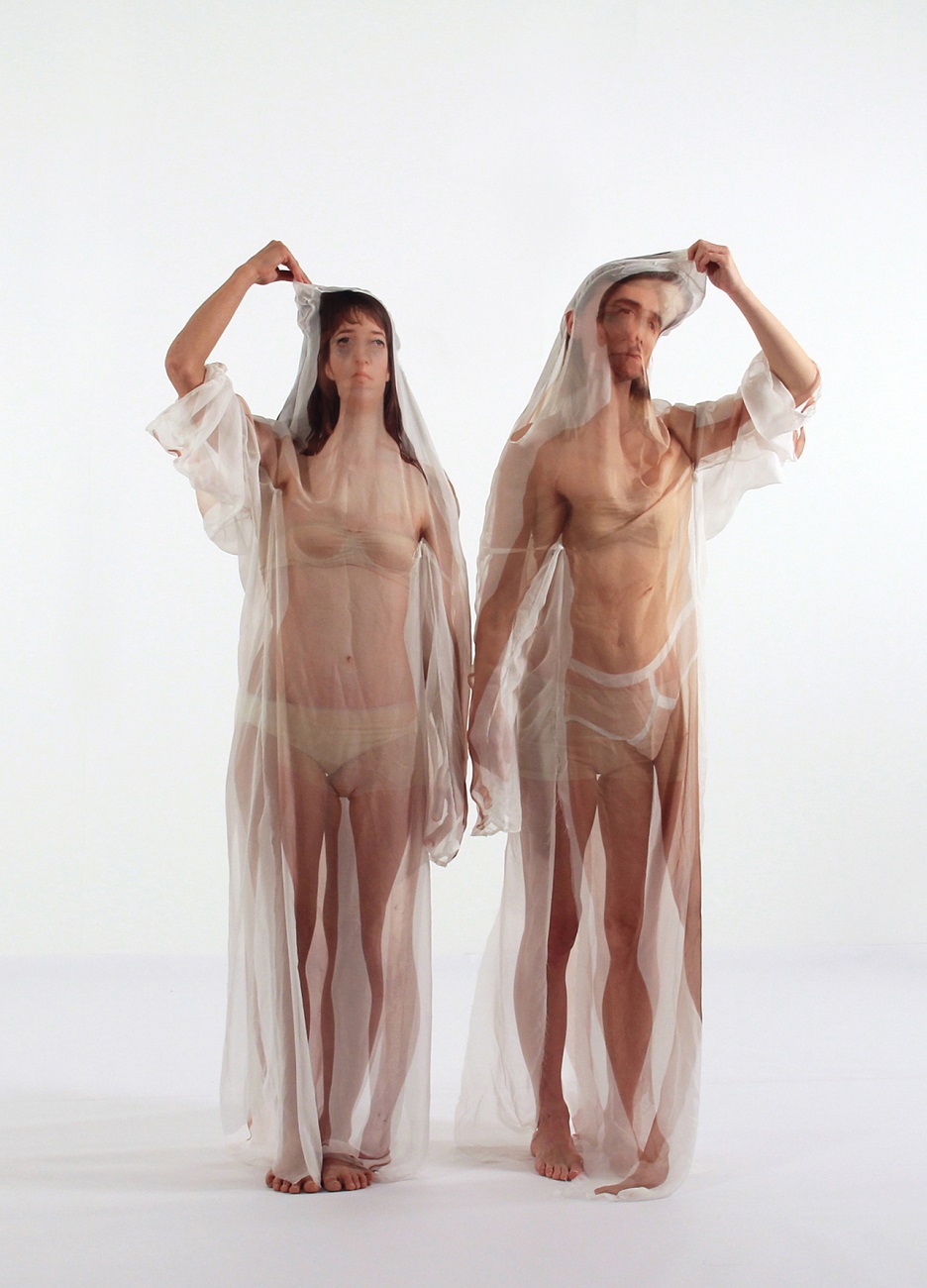
Filippo Nassetti and Vincenzo Reale
Thalassic Masks
The Thalassic Masks project focuses on rethinking the protective mask, transforming a medical product, born in a state of emergency, into a design statement expressing contemporary identities.

Thalassic Masks
The Thalassic Masks project focuses on rethinking the protective mask, transforming a medical product, born in a state of emergency, into a design statement expressing contemporary identities.

요르단 울프슨
ジョーダンウォルフソン
Female Figure
The stare of the animatronic sculpture is so intense, it would put anyone uncomfortable. The mask is probably there as a way to avoid creating a human face using animatronics but it also definitely adds to the creepiness of the overall look. The importance of the gaze is found throughout Wolfson’s work but it finds here a very special interpretation. He gives the ability to gaze to two different entities, a stripper and a robot, who are by definition never supposed to look up. The visitor is no longer in control of the situation, creating the awkwardness that is at the core of the work.

Torus
Directed by British fashion photographer Nick Knight of SHOWStudio, Torus is a film on human connection and loneliness featuring choreography by Wayne McGregor and styling by Norwegian designer Fredik Tjærandsen. Performed by Company Wayne McGregor, Torus shows dancers wearing inflatable balloons designed by Tjærandsen, orbiting in darkness as isolated entities, occasionally lit as they transition through a temporal universe, a mirror to the life that many are only passing through, barely connecting.

Great Chain of Being
FILE FESTIVAL
The great chain of being, an ancient philosophical concept, attempted to explain the structures and relationships of the world as a form of hierarchy or set of strata. This philosophical idea is here expressed in the form of the entities that constitute the contemporary world. The philosophers of the past believed that the structure of the world had at its top a god, and that beneath there were angels, animals, plants, and elements. But this conception of the world, as a result of the changes in civilization and culture, resulted in the elements that constitute the world undergoing a transition and sustaining an unforeseen hierarchy. The works of art depict the contemporary structure in the form of robots, machines, people, animals, and virtual or digital entities. Within virtual systems, these entities undergo a process of creation, arrangement, use, disposal and recycling, through which they emerge and disappear. The work depicts the stories emerging from these processes, against the background of a systemically designed landscape akin to a factory.
video

“Entropy Wrangler,” Ian Cheng’s 2013 exhibition at Off Vendome in Dusseldorf, was an excellent introduction to the logic behind this artist’s practice. The centerpiece was a large projection in the gallery’s basement described as “a live computer simulation that changes and evolves, forever.” Like all of Cheng’s simulations, it was programmed with motion capture techniques that register the physical movements of performers that are then translated onto digital bodies. These bodies coexist as individual entities subject to the laws and dynamics of a causal, virtual world: avatars of people and common objects, like hammers and basketball players, rendered in basic three-dimensional form and caught in the zero gravity of the digital screen

Urban imprint
“If there is to be a “new urbanism… it will no longer be concerned with the arrangement of more or less permanent … but for the creation of enabling fields….that refuse to be crystallized into definitive form; it will no longer be about meticulous definitions, the imposition of limits, but about expanding notions, denying boundaries, not about separating and identifying entities, but about discovering hybrids; it will no longer be obsessed with the city but with the manipulation of infrastructure for endless intensifications and diversifications, shortcuts and redistributions – the reinvention of psychological space.”, Dutch architect + Harvard Professor, Koolhaas 959, writer of Delirious New York. URBAN IMPRINT is how we design a piece of this new urbanism, an augmented materiality , as we define it. An environment that is a ‘blank canvas’ to be reshaped by the future self.

Life after bob
Ian Cheng’s Life After BOB is an episodic anime series built in the Unity game engine and presented live in real-time. Bridging the artist’s interest in simulation’s capacity to generate emergent surprising phenomena, with cinematic storytelling’s capacity to evoke deep psychological truths, Life After BOB imagines a future world in which our minds are co-inhabited by AI entities. Life After BOB asks: How will life lived with AI transform the archetypal scripts that guide our sense of a meaningful existence?

Skia
file festival
As natural as the daily sunshine, one’s shadow, formerly a constant companion, now often escapes from attention. A silhouette of our physical form, one’s shadow is no more than a flat, disembodied reduction of the contours of one’s self.The installation skia examines the interplay of our shadows and our conscious awareness of our physical displacement of space. In this closed-circuit installation, visitor´s images are manipulated and projected as artificial shadows.What does it mean if one’s shadow suddenly frees itself and develops an alien autonomy? And what has such an estrangement in common with the multiple identities of the post modern ego?

Difference and Repetition
The title references Deleuze’s thesis ‘Difference and Repetition’ – his attempt to understand reality without referring to identities. The artists aim to ‘unidentify’ the audience – to criticize the bubbles of reality which technology has helped us to build around ourselves. By allowing ourselves to remove our identity occasionally, we can better understand the thoughts of those we disagree with and therefore better work together to build a combined reality. Difference (in both senses) is generated by the motion control system which continuously changes the pose of the mirrors relative to the viewer. This movement disrupts space itself, creating a transformation similar to that of a Lorentz transformation when one travels close to the speed of light. This causes space itself to compress, twist and break, giving the viewer a tool for observing the non-absolute nature of time.

UK Pavillion
THE POEM PAVILION FEATURES A BREATHTAKING ILLUMINATED ‘MESSAGE TO SPACE’ TO WHICH EACH OF THE EXPO’S ANTICIPATED 25 MILLION VISITORS WILL BE INVITED TO CONTRIBUTE. “THE IDEA DRAWS DIRECTLY ON ONE OF STEPHEN HAWKING’S FINAL PROJECTS, ‘BREAKTHROUGH MESSAGE’, A GLOBAL COMPETITION THAT HAWKING AND HIS COLLEAGUES CONCEIVED IN 2015 INVITING PEOPLE WORLDWIDE TO CONSIDER WHAT MESSAGE WE WOULD COMMUNICATE TO EXPRESS OURSELVES AS A PLANET, SHOULD WE ONE DAY ENCOUNTER OTHER ADVANCED CIVILIZATIONS IN SPACE. WHAT IF THE UK PAVILION AT EXPO 2020 BECOMES A PLACE WHERE VISITORS FROM ALL OVER THE WORLD TAKE PART IN A COLLECTIVE GLOBAL PROJECT THAT SHOWCASES BRITISH EXPERTISE IN A.I. TECHNOLOGIES AND POETRY WHILE TRANSCENDING NATIONAL IDENTITIES?” Es Devlin

Eyes
Eyes is an interactive art installation and a series of biometric data artworks with my previous artwork Digiti Sonus. It’s an interactive biometric data art that transforms human’s Iris data into musical sound and 3D animated image. The idea is to allow the audience to explore their own identities through unique visual and sound generated by their iris patterns based on iris recognition and image processing techniques. As a part of the installation, selected distinctive iris images are printed in 3D sculptures, and it replays the sound generated from the iris data and projects 3D converted image images. The audience members can compare their iris-based sonic results with others, and question the “problem of disembodied identities’ in the digital era through the existence of audiovisual representations of individuals.

Antrum
The installation looks like a grotto of the membrane, the surface of which is inhabited by strange creatures. It’s complex structure causes association with living creatures, space objects and architectural constructions. In this frontier word pure mathematical abstractions are mixed with natural shapes, resulting in formation of new entities. Viewers can push the membrane and try to contact with them.
AVATAR X Lab
The project is a partnership between ANA Holdings Inc. and Japan Aerospace Exploration Agency (JAXA); a part of AVATAR X, a collaborative program for the advancement of space exploration and development. ANA and JAXA are both experts at launching vehicles into the atmosphere, the feeling of suspension or ‘being in the air’ is natural for both entities. The AVATAR X Lab Building is designed as a suspended building floating above a moon-like crater. The multi-story structure floats eighteen meters above the crater bottom, and is accessible by a bridge. When astronauts board a spacecraft they cross a bridge; when we board a plane we walk across a jet bridge between the terminal and airplane. This is our last contact with familiar ground before taking off for someplace new. The suspended building embodies this crossing of thresholds: after passing over the bridge you are transported to a new place, the AVATAR X Lab Building, where technological innovation will change how we see the world.

FALIN MYND
Falin Mynd is an audiovisual installation dedicated to the city of Milan that draws inspiration from the concept of the latent image in the photographic field: an invisible imprint left by the light on the film that is revealed only after its development. Similarly, the data generated by the inhabitants and visitors of the city of Milan produce abstract digital landscapes, leaving a trace from their analysis and interpretation in real-time. In this way, the work makes visible the indissoluble bond between individual and community, highlighting how the two entities influence one another changing the perception of the reality surrounding us made of places, people, colors, and sensations. The data thus constitute an invisible image of the city, a map of what is not manifest and which is revealed in Falin Mynd.

Memopol
Memopol-3 is an installation that visualizes visitor’s information field. It’s an Orwellian dystopia which is built on the technology of today. The tools of surveillance economy are abused to create a personal physical surveillance experience. Physical and virtual identities are quantified and processed into a stream of data. After the phases of data collection the visitor experiences a transcendent reflection of oneself that combines the past and the future, physical and immaterial into an audio-visual ceremony.

Deep Screen
Muti Randolph lives in Rio de Janeiro and studied Visual Communications and Industrial Design at the Pontificia Universisade Católica do Rio de Janeiro. One of the pioneers in computer art, animation and 3d illustration in Brazil, he has been shifting from virtual 3d to real 3d spaces creating visual identities, graphics, illustrations, sets, and interior architecture projects for clients mainly in the entertainment, fashion and technology areas.

Positions of the Unknown
At the very beginning of space exploration the infrastructure to monitor the whole sky was not yet developed. So in order to find out whether foreign countries launched objects, the US government started to train citizens to observe and detect possible artificial satellites. Scattered over the allied world, these amateur scientists played a crucial part in keeping track of all men-made technology orbiting earth, until “Operation Moonwatch” was discontinued in 1975 […] “Positions of the Unknown” locates the current whereabouts of these mysterious objects by simply pointing at them as they revolve around Earth. Missing the legal proof, those unidentified artefacts remain entities of pure speculation, secret companions of us and our planet. Even so they have been sighted several times and their ubiquitous presence is therefore somehow validated, they linger in a state between existence and non-existence. Quadrature’s 52 small machines constantly follow their paths and serve as silent witnesses of the unknown.

史上第一位進入太空的藝術家
Bionic Angel
The work series “bionic angel” takes as its starting point the future transformation and technological control of human evolution. Rapid development in the field of so-called “g-r-i-n techno-logies” (genetics, robotics, information and nano-techno- logies) are changing our bodies, minds, memories, and identities, but also impact on our progeny. These technologies all converge with the aim of enhancing human performance. Prenatal genetic determination enables children to be built to plan.

ماریکو موری
森万里子
МОРИ, МАРИКО
The ring
Born in Tokyo in 1967, Mariko Mori first made an impact on the international art scene in the early-mid 1990s. Her perfectly-formed and powerfully ambitious sculptural and photographic work of that period was an immediately accessible reflection on the ways our identities were being shaped by various technologies and the philosophies driving them.

Parades & Changes
Parades & Changes, replays is a full scale re-creation of the masterpiece Parades & Changes, a major 1965 work of American postmodern dance legend Anna Halprin. The provocative Parades & Changes, Halprin’s first “collective creation” dynamited the codes dominating dance by exposing the process of performance: improvising around several “scores,” dancers dress and undress, inventing gestures and vanishing naked in rolls of skin colored paper. This “ceremony of trust,” as it was named by Halprin, seeks to utilize dance as a medium for being together: her prolific composition addresses the process, the place, the action, and the performer as both unique and corresponding entities.

Имме Ван Дер Хаак
Beyond the Body
“My work focuses on altering the human form by affecting its figure with just one simple intervention. Photos of the human body are printed onto translucent silk which will create the possibility of physically layering different bodies, ages, generations and identities. In a dance performance, the moving body manipulates the fabric so the body and the silk become one, distorting our perception or revealing a completely new physical form. The movement then brings this to life.”

Putting The Pieces Back Together Again
The kinetic installation “Putting the Pieces Back Together Again” is a complex system with self-organizing and emergent behaviour, at the same time it is an artistic inquiry and meditation on contemporary scientific methodology. The installation investigates non-hierarchical communication and collective behaviour by implementing such a system physically through many electro-mechanical actors.
The Installation consists of 1250 stepper motors arranged in a two dimensional grid of two by two meters. Each motor is equipped with a pointer made from white acrylic glass. The radii of the pointers are chosen to intersect with the pointers of its neighbours. All motors are excited with the same alternating current that let them move initially in a random direction. Each actor is at the same time sensing its environment. In the event of a collision the pointers reverse their turning direction. This is achieved through a custom motor control circuit. Through the interplay of many entities a complex behaviour emerges on the surface of the installation. By manipulating the signals during runtime the system will form spontaneous pattern on its surface. It seems like they are negotiating it’s position with nearby actors. By this the system is showing behaviour of self-organization. The installation drifts through various activation levels during its run time by this it constantly evolves new formations and constellations (crystallization).

Multiple Identities, Sustainable Development
The focus is on multiple identities. There are pale, milky plastic pipes attached to the ceiling of the concrete interior, inside which, moved by fans, roll white balls. One after the other. If the one arrives, a new one is sent to another tube.Such works breathe inner unity. This closeness is sometimes a closeness, if not encryption. Because the language of contemporary installation art is foreign and difficult to read. The viewer’s gaze likes to evaluate subjectively and is always shaped by environmental influences such as culture, trends, styles, beliefs, experiences and politics. This makes the interpretation uncertain, it becomes subjective, often tempting to misconduct. Because anyone who claims that the work of art is created in the eye of the beholder and means that everyone, regardless of where they come from and how educated, can make a valid statement about a work of art is wrong. What Marcel DuChamp meant is that it unfolds in the eye of the beholder. But this development should not mean that simply opening the eyes also brings with it knowledge and insight. These qualities are developed through active participation, through perception. This, in turn, is not only feasible through the visual stimulus in the eye. It is possible, however, if you know who the artist is, what he is doing, what he wishes to express and with which underlying design principles the view is guided in what way to what. Only then does the processing take place, a connection of the causal relationships, which ultimately leads to art in the eye of the beholder. To an inner feeling outside of the spontaneous feelings.